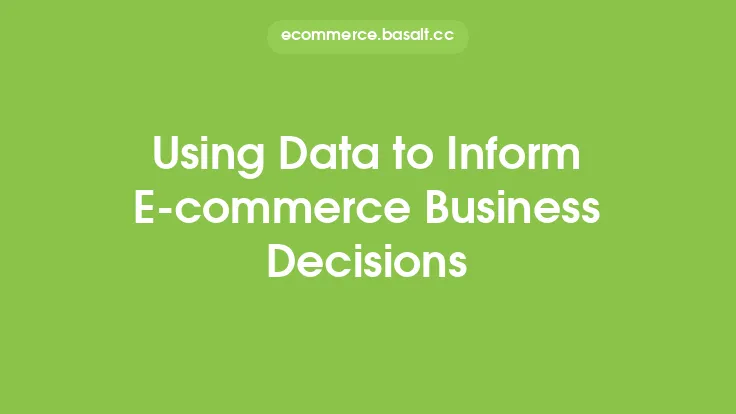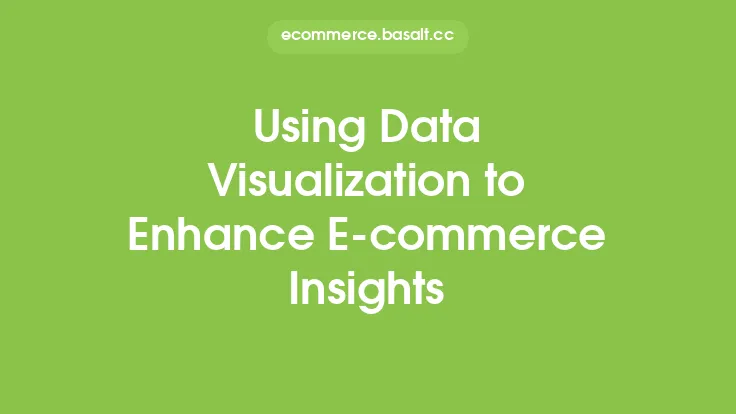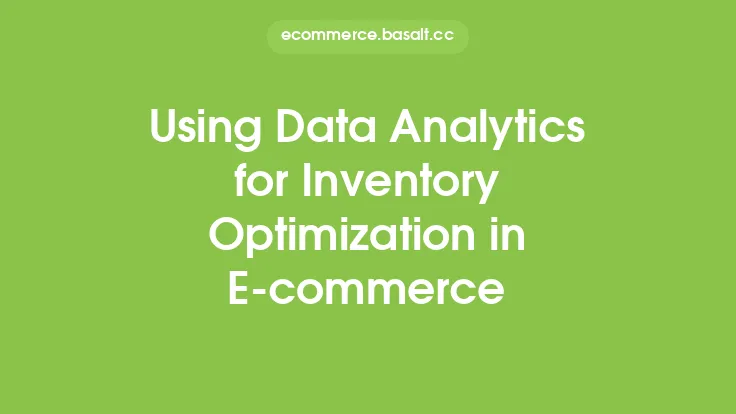In the rapidly evolving world of e-commerce, data analytics has emerged as a crucial tool for driving business growth. The ability to collect, analyze, and interpret large amounts of data has become essential for e-commerce companies to stay competitive and make informed decisions. With the vast amount of data available, e-commerce businesses can gain valuable insights into customer behavior, preferences, and shopping patterns, enabling them to optimize their strategies and improve overall performance.
Introduction to Data Analytics in E-commerce
Data analytics in e-commerce involves the use of various techniques and tools to analyze data from different sources, such as website interactions, social media, customer feedback, and sales data. This analysis helps e-commerce businesses to identify trends, patterns, and correlations that can inform their marketing, sales, and customer service strategies. By leveraging data analytics, e-commerce companies can gain a deeper understanding of their customers, improve their online presence, and ultimately drive business growth.
Benefits of Data Analytics in E-commerce
The benefits of using data analytics in e-commerce are numerous. Some of the most significant advantages include:
- Improved customer insights: Data analytics helps e-commerce businesses to understand their customers' behavior, preferences, and shopping patterns, enabling them to create targeted marketing campaigns and personalized shopping experiences.
- Enhanced operational efficiency: Data analytics can help e-commerce companies to optimize their supply chain, inventory management, and shipping processes, leading to reduced costs and improved customer satisfaction.
- Increased revenue: By analyzing sales data and customer behavior, e-commerce businesses can identify opportunities to upsell and cross-sell products, leading to increased revenue and average order value.
- Better decision-making: Data analytics provides e-commerce companies with accurate and timely data, enabling them to make informed decisions about their business strategies and operations.
Types of Data Analytics in E-commerce
There are several types of data analytics that e-commerce businesses can use to drive growth. These include:
- Descriptive analytics: This type of analytics involves analyzing historical data to understand what has happened in the past. Descriptive analytics can help e-commerce businesses to identify trends and patterns in customer behavior and sales data.
- Predictive analytics: This type of analytics involves using statistical models and machine learning algorithms to forecast what may happen in the future. Predictive analytics can help e-commerce businesses to predict customer behavior, sales, and revenue.
- Prescriptive analytics: This type of analytics involves using data and analytics to recommend specific actions or decisions. Prescriptive analytics can help e-commerce businesses to identify opportunities to improve their operations and make data-driven decisions.
Data Analytics Tools for E-commerce
There are many data analytics tools available for e-commerce businesses, ranging from simple and affordable solutions to complex and expensive ones. Some of the most popular data analytics tools for e-commerce include:
- Google Analytics: This is a free tool that provides insights into website traffic, behavior, and conversion rates.
- Adobe Analytics: This is a paid tool that provides advanced analytics and insights into customer behavior and sales data.
- Tableau: This is a data visualization tool that helps e-commerce businesses to create interactive and dynamic dashboards and reports.
- SAS: This is a paid tool that provides advanced analytics and data management capabilities for e-commerce businesses.
Implementing Data Analytics in E-commerce
Implementing data analytics in e-commerce requires a strategic approach. E-commerce businesses should start by identifying their goals and objectives, such as improving customer insights or increasing revenue. They should then select the most appropriate data analytics tools and techniques to achieve these goals. It is also essential to ensure that data analytics is integrated into all aspects of the business, from marketing and sales to customer service and operations. Additionally, e-commerce businesses should invest in training and development to ensure that their employees have the necessary skills and knowledge to work with data analytics.
Best Practices for Data Analytics in E-commerce
To get the most out of data analytics, e-commerce businesses should follow best practices such as:
- Collecting and analyzing data from multiple sources: This can include website interactions, social media, customer feedback, and sales data.
- Using data visualization tools: Data visualization tools can help e-commerce businesses to create interactive and dynamic dashboards and reports, making it easier to understand and interpret complex data.
- Focusing on key performance indicators (KPIs): E-commerce businesses should identify and track KPIs that are relevant to their goals and objectives, such as conversion rates, average order value, and customer satisfaction.
- Continuously monitoring and evaluating data: E-commerce businesses should regularly review and analyze their data to identify trends, patterns, and correlations that can inform their business strategies.
Common Challenges in Data Analytics for E-commerce
Despite the many benefits of data analytics, e-commerce businesses may face several challenges when implementing and using data analytics. Some of the most common challenges include:
- Data quality and accuracy: E-commerce businesses must ensure that their data is accurate, complete, and up-to-date to get reliable insights and make informed decisions.
- Data integration: E-commerce businesses may struggle to integrate data from multiple sources, such as website interactions, social media, and sales data.
- Lack of skills and knowledge: E-commerce businesses may need to invest in training and development to ensure that their employees have the necessary skills and knowledge to work with data analytics.
- Data security and privacy: E-commerce businesses must ensure that they are collecting, storing, and analyzing data in a secure and privacy-compliant manner.
Future of Data Analytics in E-commerce
The future of data analytics in e-commerce is exciting and rapidly evolving. With the increasing use of artificial intelligence, machine learning, and the Internet of Things (IoT), e-commerce businesses will have access to even more data and analytics capabilities. Some of the trends that are expected to shape the future of data analytics in e-commerce include:
- Increased use of real-time analytics: E-commerce businesses will be able to analyze and respond to customer behavior and sales data in real-time, enabling them to make faster and more informed decisions.
- Greater emphasis on customer experience: Data analytics will play a critical role in helping e-commerce businesses to create personalized and seamless customer experiences across all touchpoints and channels.
- More focus on predictive and prescriptive analytics: E-commerce businesses will use predictive and prescriptive analytics to forecast customer behavior, sales, and revenue, and to recommend specific actions and decisions.





